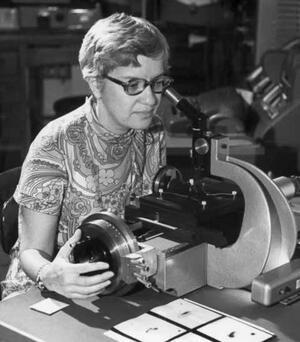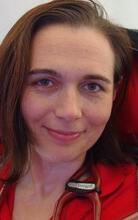Vera Cooper Rubin
Courtesy of Vera Rubin
Far ahead of her time, Vera Cooper Rubin theorized that galaxies clustered and moved in ways that defied the Big Bang Theory and helped prove the existence of dark matter. It took decades for other scientists to examine and agree with these theories. Rubin taught at Georgetown for ten years beginning in 1955 before joining the Department of Terrestrial Magnetism of the Carnegie Institution of Washington. There she helped find some of the first direct evidence confirming that the universe’s mass is mostly dark matter and found dark matter in over 200 galaxies throughout her career. Among her many accolades, Rubin earned a 1993 Presidential National Medal of Science and in 1981 was the second woman elected to the National Academy of Sciences.
Early Life and Education
Vera Cooper Rubin forever changed our fundamental view of the cosmos, from a universe dominated by starlight to one dominated by dark matter. Rubin was born on July 23, 1928, in Philadelphia, Pennsylvania, the younger of two daughters of electrical engineer Philip Cooper and his wife Rose (Applebaum). Philip Cooper encouraged his daughter’s interest in astronomy, taking her to amateur astronomy meetings after the family moved to Washington, D.C., and assisting in her first homemade telescope when she was fourteen.
Vera discovered early that women science students were not accepted at some universities. Her early experiences shaped her later work for women’s equality in the sciences, especially astronomy. Rubin received her B.A. from Vassar in 1948 and her M.A. from Cornell University in 1951, where she met and married Robert Rubin, a graduate student in physical chemistry.
Research Contributions and Work
Rubin’s controversial master’s thesis examined the possibility of a bulk rotation in the universe by looking for “non-Hubble flow.” At that time, the redshifts (lengthening of light waves due to the motion of an object, such as a star or a galaxy) for only 109 galaxies had been obtained, yet her analysis seemed to show an extra, “sideways” motion of galaxies independent of the normal Hubble recession caused by the expansion of the universe. The paper got a cold reception and was rejected by both Astronomical Journal and Astrophysical Journal. Although Rubin later agreed that perhaps her data were too skimpy, her thesis was a factor in Gerald de Vaucouleur’s claim for evidence of the “Local Supercluster.”
Rubin’s doctoral work was conducted at Georgetown University under the auspices of George Gamow. Her thesis (1954) was one of the earliest works on the clustering of galaxies. She concluded that galaxies were not randomly distributed over the sky, but instead there was a definite clumping. Her results were not followed up by the scientific community, as the subject of large-scale structure was not studied seriously until the late 1970s.
From 1955 to 1965, Rubin rose from research associate to assistant professor at Georgetown, and from 1963 to 1964 she engaged in work on the rotation of galaxies with the famed husband-wife team of Geoffrey and Margaret Burbidge. In 1965, Rubin joined the staff of the Department of Terrestrial Magnetism of the Carnegie Institution of Washington. It was during this year that Rubin became the first woman to observe “legally” at Mount Palomar Observatory under her own name as a guest investigator.
In the early 1970s, Rubin renewed her interest in non-Hubble flow, and, with W. Kent Ford, she found evidence again for extra motion. The “Rubin-Ford effect” has been called spurious by some and well-established by others. Rubin is perhaps best-known for her work with Ford and others on the rotation curves of spiral galaxies, using newer technology to update the groundbreaking work of the Burbidges. Rubin found that spiral galaxies have “flat rotation curves.” Unlike our solar system, in which the majority of the matter is contained in the sun, and thus the planets follow Keplerian motion with Mercury having a much faster orbital velocity than Pluto, the luminous matter in spiral galaxies has a high orbital velocity out to the visible edge. This is usually explained as due to the fact that the bulk of the galaxy’s mass is not clustered at the center, where the visible bulge of the galaxy is, but there exists a halo of dark matter extending at least to the visible edge, if not farther. Thus, Rubin and her collaborators provided some of the first direct evidence for the existence of dark matter, verifying the earlier theoretical work of Jeremy Ostriker and James Peebles. Since 1978, Rubin has analyzed the spectra of over two hundred galaxies and found that nearly all contain copious amounts of dark matter.
Honors and Recognition
Rubin held four honorary doctorates, a 1993 Presidential National Medal of Science, the 1994 Dickson Prize in Science from Carnegie-Mellon University, and the 1994 Russell Lectureship Prize of the American Astronomical Society. In 1981, she became the second woman astronomer to be elected to the National Academy of Sciences. She served as associate editor of Astronomical Journal from 1972 to 1977 and of Astrophysical Journal Letters from 1977 to 1982. In addition to numerous scientific papers, she published Bright Galaxies, Dark Matter, a collection of less technical articles designed for the general public, in 1997.
On January 16, 2004, the National Academy of Sciences awarded Rubin its James Craig Watson Medal for “her seminal observations of dark matter in galaxies… and for generous mentoring of young astronomers, men and women.”
Remembering what it was like to be a lone woman staring at galaxies, Vera Rubin considered it a responsibility and a privilege to be a mentor. “It is well known,” she said, “that I am available twenty-four hours a day to women astronomers.”
In her book “Bright Galaxies, Dark Matters,” Rubin wrote, “I live and work with three basic assumptions. (1) There is no problem in science that can be solved by a man that cannot be solved by a woman. (2) Worldwide, half of all brains are in women. (3) We all need permission to do science, but, for reasons that are deeply ingrained in history, this permission is more often given to men than to women.”
Reflecting on her Jewish identity, Rubin said in an interview, “In my own life, my science and my religion are separate. I'm Jewish, and so religion to me is a kind of moral code and a kind of history. I try to do my science in a moral way, and, I believe that, ideally, science should be looked upon as something that helps us understand our role in the universe." (Meyer)
Rubin passed away on December 25, 2016, in an assisted living facility in Princeton, New Jersey. She was 88. Rubin and her husband had four children: David M., Judith S., Karl C., and Allan M.—all of whom have Ph.D.s in the sciences, including daughter Judith S. Young, a noted astronomer in her own right.
Selected Works by Vera Rubin
Bright Galaxies, Dark Matter in Masters of Modern Physics Series. New York: AIP Press, 1997.
“Extended Rotation Curves of High-Luminosity Spiral Galaxies. IV. Systematic Dynamical Properties, Sa-Sc,” with W. Kent Ford Jr. and N. Thonnard, The Astrophysical Journal Letters 225 (1978): L107–111.
“Fluctuations in the Space Distribution of the Galaxies.” Proceedings of the National Academy of Sciences 40 (1954): 541–549.
“Rotational Properties of 21 Sc Galaxies with a Large Range of Luminosities and Radii, from NGC 4605 (R = 4 kpc) to NGC 2885 (R = 122 kpc),” with W. Kent Ford, Jr., and N. Thonnard. Astrophysical Journal 238 (1980): 471–487.
“Weighing the universe: dark matter and missing mass.” In Bubbles, Voids and Bumps in Time: The New Cosmology, edited by James R. Cornell (1989): 73-104.
“Women’s Work.” Science 86 (July/August 1986): 58–65.
Bartusiak, Marcia. Through a Universe Darkly: A Cosmic Tale of Ancient Ethers, Dark Matter, and the Fate of the Universe. 1st ed. New York: Harper Collins, 1993.
Bartusiak, Marcia. “The Woman Who Spins the Stars.” Discover (October 1990): 88–94;
Lightman, Alan P., and Roberta Brawer. Origins: The Lives and Worlds of Modern Cosmologists. Cambridge, Mass: Harvard University Press, 1990.
Stille, Darlene R. Extraordinary Women Scientists, 1995.
Who’s Who in America 1996. New Providence (N.J.): Marquis who’s who, 1995.
Yount, Lisa. Contemporary Women Scientists. American Profiles. New York, NY: Facts on File, 1994.
Schudel, Matt. “Vera Rubin, Astronomer Who Proved Existence of Dark Matter, Dies at 88.” Washington Post, December 26, 2016, sec. National. https://www.washingtonpost.com/national/vera-rubin-astronomer-who-verif….
Meyer, Gabriel . “Pontifical Science Academy Banks on Stellar Cast.” EWTN Global Catholic Television Network. https://www.ewtn.com/catholicism/library/pontifical-science-academy-banks-on-stellar-cast-11056.




